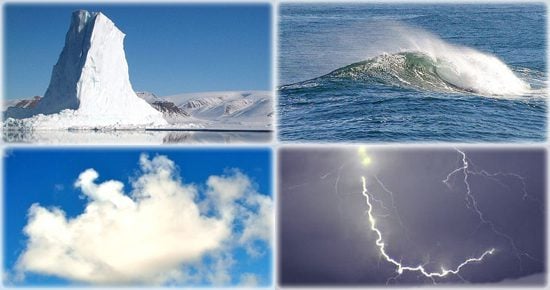The Four Elements are, by definition, fundamental to many forms of Paganism, particularly Wicca. But in the modern world, I find it difficult to reconcile the four classical elements of Earth, Air, Fire and Water with the 100 or so chemical elements of science – how can I refer to the Four Elements when I know that the reality is far more complex?

Instead, like many modern Pagans, I find it much easier to attribute the Four Elements with the four states of matter in science – solid, liquid, gas and plasma. In fact, the four classical elements fit the four states of matter so well, it could be that our ancestors had something of an inkling that the world around them consisted of these states of matter, but not knowing about atoms they had to use the analogy of the Four Elements to explain them. This is how the Four Elements correspond with the four states of matter…
Earth = Solid
The solid state of matter is the state that we usually find most familiar. Most solid items can be seen, touched and represented easily. It is the state in which particles are the lowest energy, but most highly ordered. Solids are strong and stable, holding their shape; the word “solid” as an adjective has connotations of reliability, durability and truthfulness. When forced to change, solids break rather than change shape.
When working with the energies of Earth, we should think of these qualities – strong, stable, safe and orderly, but also inflexible, heavy, cold and low in energy.
 Water = Liquid
Water = Liquid
Liquid is the second state of matter. Its particles have a little more energy than a solid, so they can slide over each other. This gives liquid its ability to take the shape of any container that holds it, and to flow.
As a liquid itself, Water exhibits these qualities. In magic, Water energy is slightly higher than a solid, and can be considered more versatile, but it is still fairly self-contained as well as being cold and heavy.
 Air = Gas
Air = Gas
Heat a liquid enough and it’ll evaporate into gas. Gas is a highly energised state of matter; the particles have all broken free of each other and move in random directions. As a result, gases are formless and often invisible – this makes them somewhat mysterious for humans.
Air, the mix of gases that we are so familiar with and depend upon, is the element attributed with qualities of lightness, energy and warm. It’s also associated with intellect and intuition, perhaps because gases are generally invisible, just like human thought – we say things like, “oh, I just plucked that idea out of the air.”
When a gas is heated to extreme temperatures, the very atoms themselves are ripped apart, the electrons breaking free from protons to become free-flowing, forming a plasma. Plasmas in nature can be found in lightning, stars and some kinds of flame.
Although most flames aren’t really plasma (they are reacting gases), the element of Fire certainly has many of the qualities of a plasma: Extreme energy and heat, a strong connection with light, chaotic behaviour, weightlessness, and destructiveness. That’s why working with Fire energy in magic requires caution – it is extremely powerful but can be dangerous! The word “plasma” often makes us think of futuristic, space-age techology, and this can be carried across to Fire energy – use it when invoking something new and revolutionary.
 Aether/Void/Spirit = Spacetime
Aether/Void/Spirit = Spacetime
Many traditions include a fifth element, often called Aether or Void or Spirit, which is the most mysterious element of all. It’s either considered an “everythingness,” a pervasive force exisiting throughout all the other elements, or a “nothingness,” devoid of anything at all, or somehow a combination of the two.
I equate the fifth element with Spacetime, the “structure” of existence itself which results in gravity. Spacetime consists of “quantum foam,” a seething sea of potential at the tiniest scale possible in which virtual particles exist for almost no time before disappearing. It’s the ultimate “everything in nothingness,” equating very well to the idea of the aether. Think of Spacetime when working with the fifth element – something infinitely unknowable yet with infinite potential.
State of matter images by ElfQrin, CC Wikimedia Commons.
Spacetime image by Mysid, CC Wikimedia Commons.


















